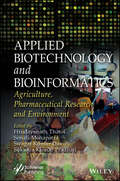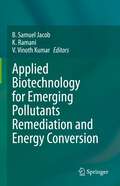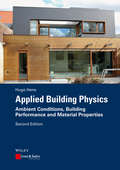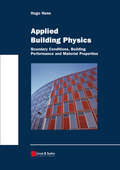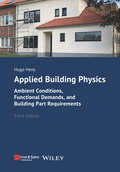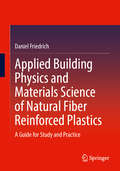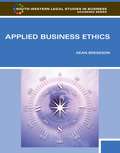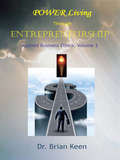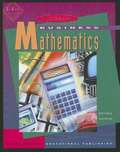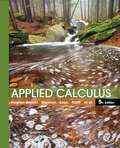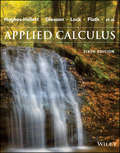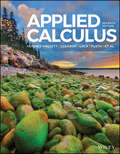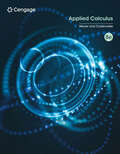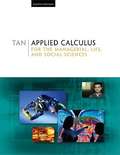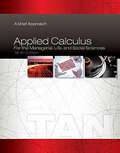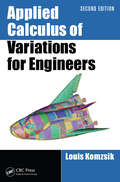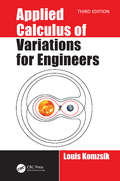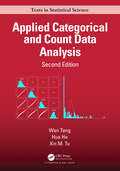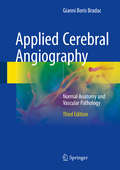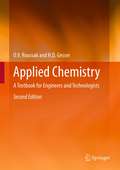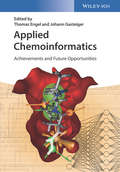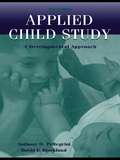- Table View
- List View
Applied Biotechnology and Bioinformatics: Agriculture, Pharmaceutical Research and Environment
by Hrudayanath Thatoi Sonali Mohapatra Swagat Kumar Das Sukanta Kumar PradhanThis comprehensive reference book discusses the convergent and next-generation technologies for product-derived applications relevant to agriculture, pharmaceuticals, nutraceuticals, and the environment. The field of modern biotechnology is a multidisciplinary and groundbreaking area of biology that includes several cutting-edge methods due to developments in forensics and molecular modeling. Bioinformatics is a full-fledged multidisciplinary field that combines advances in computer and information technology. Numerous applications of bioinformatics—primarily in the areas of gene and protein identification, structural and functional prediction, drug development and design, folding of genes and proteins and their complexity, vaccine design, and organism identification—have contributed to the advancement of biotechnology. Biotechnology is also essential to crop improvement in agriculture because it allows genes to transfer across plants to increase traits such as disease resistance and yield. It also plays a broad role in healthcare, including genetic testing, gene therapy, pharmacogenomics, and drug development. Bioremediation and biodegradation, using microbial technologies to clean up environmental contamination, waste management technologies, and the conversion of organic waste to biofuels. Bioinformatics plays a critical role in analyzing different types of data created by high-throughput research methods—such as genomic, transcriptomic, and proteomic datasets—that are useful in addressing various problems related to disease management, clean environment, alternative energy sources, agricultural productivity, and more. Audience The book will interest biotechnology researchers and bioinformatics professionals working in the areas of applied biotechnology, bioengineering, biomedical sciences, microbiology, agriculture and environmental sciences.
Applied Biotechnology for Emerging Pollutants Remediation and Energy Conversion
by B. Samuel Jacob K. Ramani V. Vinoth KumarThis contributed volume comprises of detailed chapters covering the biotechnological approaches employed for the removal of toxic recalcitrant xenobiotics such as petroleum hydrocarbons, textile dyes, microplastics and synthetic polymers that pose serious threat to the environment. It also includes the waste to energy conversion strategies that provides a deep insight on the need for waste circular economy for different developing countries and its implication on sustainable development goals such as SDG 12 (responsible consumption and production) SDG 14 (Life below water); and SDG 15 (Life on land). Emerging pollutants sourced from both industries and anthropogenic activity have created havoc in recent years for public health and destruction of biodiversity at multiple levels. The alarming increase in the global population and rapid industrialization might aggravate the problems associated with these hazardous pollutants in near future. Effluent from different industries may contain high amounts of xenobiotic hazardous contaminants such as dyes, hydrocarbons, synthetic surfactants, microplastics, etc. Industries and public sewers handling such waste streams are facing a plethora of challenges in the effluent treatment and solid waste disposal due to various factors that start from production to adoption of appropriate technologies. Therefore, there is an immediate circumvention of bottlenecks through sustainable mitigation strategies. This book is of interest to teachers, researchers, climate change scientists, capacity builders and policymakers. Also, the book serves as additional reading material for undergraduate and graduate students of agriculture, forestry, ecology, soil science, and environmental sciences. National and international agricultural scientists, policy makers also find this to be a useful read.
Applied Building Physics: Ambient Conditions, Building Performance and Material Properties
by Hugo S. HensBad experiences with construction quality, the energy crises of 1973 and 1979,complaints about `sick buildings?, thermal, acoustical, visual and olfactory discomfort, the need for good air quality, the move towards more sustainability ? all these have accelerated the development of a field that, for a long time, was hardly more than an academic exercise: building physics. The discipline embraces domains such as heat and mass transfer, building acoustics, lighting, indoor environmental quality and energy efficiency. In some countries, fire safety is also included. Through the application of physical knowledge and its combination with information coming from other disciplines, the field helps to understand the physical phenomena governing building parts, building envelope, whole building and built environment performance, although for the last the wording `urban physics? is used. Building physics has a real impact on performance-based building design. This volume on `Applied Building Physics? discusses the heat, air and moisture performance metrics that affect building design, construction and retrofitting.
Applied Building Physics: Boundary Conditions, Building Performance and Material Properties
by Hugo S. HensThe energy crises of the 1970s, persisting moisture problems, complaints about sick buildings, thermal, visual and olfactory discomfort, and the move towards more sustainability in building construction have pushed Building Physics to the forefront of building innovation. The societal pressure to diminish energy consumption in buildings without impairing usability acted as a trigger to activate the whole notion of performance based design and construction. As with all engineering sciences, Building Physics is oriented towards application, which is why, after a first book on fundamentals this second volume examines performance rationale and performance requirements. Outdoor and indoor climate conditions are described and calculation values are discussed, the performance concept is specified at the building level and at the building envelope level, and heat-air-moisture material properties are defined. The book incorporates 35 years of teaching Building Physics to architectural, building and civil engineers, bolstered by 40 years of experience, research and consultancy.
Applied Building Physics: Ambient Conditions, Functional Demands, and Building Part Requirements
by Hugo S. HensWhile the first volume on building physics deals with the physical principles of heat, air and moisture behaviour of buildings, building structures and components, this second volume on applied building physics focuses on the question of what the desired performance of buildings consists of. To achieve this, knowledge of the external environmental effects and the internal live loads to which buildings are subjected is a necessary first step. Subsequently, the performance requirements and the physical correspondences are deepened with the determination of their physical parameters, at the levels of buildings, building structures and building components. Compared to the second edition, the discussion of criteria is not limited to thermal comfort, but also includes acoustic, visual and olfactory aspects. Likewise, the indoor air quality is considered in a broader way. Analyses and calculations result in sustainable buildings with a comfortable indoor climate from functional and durable building constructions. Compared to the second edition, the text for the third edition has been reorganised, corrected, revised and expanded where appropriate. A useful appendix for quick reference contains standard values of material properties for a wide range of building materials. The analyses and calculations described in this book result in sustainable buildings made of functional and durable building constructions, with comfortable and healthy indoor climate and air quality. Compared to the second edition the text in this third edition has been reshuffled, corrected, reworked and extended where appropriate.
Applied Building Physics and Materials Science of Natural Fiber Reinforced Plastics: A Guide for Study and Practice
by Daniel FriedrichThe transfer of theoretical learning content to the practical application of previously unregulated bio-based building materials is the focus of this technical book. To this end, planning and design principles of thermal, moisture and sound insulation are presented and demonstrated using new types of natural fibre-reinforced plastics (NFK) in façade applications. Results from current research on LFPs and in particular on wood-plastic composites (WPC) are explained in a comprehensible way and presented graphically. It is aimed at students of architecture and civil engineering and offers numerous exam-like exercises and sample solutions to reinforce the contents. Students learn the basics of building physics and practise their application to concrete problems in building design. In addition, they can repeat and consolidate their acquired knowledge in a variety of exercises with a high level of practical relevance. Specialist planners will gain new perspectives on the selection of materials and their use in building components with the potential for more sustainability in the building industry.
Applied Business Ethics
by Dean A. BredesonThe text applies practical ethical situations to real-world business settings and decisions. The text contains thought-provoking scenarios with up-to-the-minute issues that encourage active debate among peers.
Applied Business Ethics, Volume 2: POWER Living Through Entrepreneurship
by Dr Brian KeenThis is the second book in the Applied Business Ethics series. The first volume featured the Truth, while this volume features Entrepreneurship. The Theanthropic Ethical category is one of the few scientific ethical categories. Entrepreneurs will appreciate the fact that our work is evaluated by a fellow entrepreneur, who is an ethicist by profession. Entrepreneurs drive our business communities through resolving problems. This creates wealth for all stakeholders. All successful entrepreneurs establish enterprises that are based on ethical standards. For entrepreneurs the best ethical standards are based upon scientifically verifiable, objective standards. Theanthropic Ethics© is one of the few ethical categories that entrepreneurs can depend on. Through case studies of Canadian enterprises started by entrepreneurs, you will see how some enterprises have achieved success for centuries. All were initially successful because they implemented ethical standards. Theanthropic Ethics© is thoroughly evaluated within the context of entrepreneurship. You will see that freedom is an essential component for all entrepreneurs to become successful. Three Canadian enterprises are evaluated as case studies to show the benefits of being ethical.
Applied Business Mathematics
by Robert A. Schultheis Raymond M. KaczmarskiHelps students to assess what they've learned by providing excercises pertaining to what was learned in each chapter. Includes true/false, short answer, multiple choice, etc. questions.
Applied Business Mathematics (14th Edition)
by Robert A. Schultheis Raymond M. KaczmarskiThis classic, newly-revised book presents fundamental mathematics in the context of business and consumer applications to help put readers on the path to success. The all-new 1997 edition improves upon previous editions with a wealth of updated features. The material in Applied Business Mathematics will teach the student, the mathematical and critical thinking skills that will help him be a smart shopper, an informed citizen, and a valued employee.
Applied Calculus
by Hughes-HallettApplied Calculus is praised for the creative and varied conceptual and modeling problems which motivate and challenge students. The 5th Edition of this market leading text exhibits the same strengths from earlier editions including the "Rule of Four," an emphasis on concepts and modeling, exposition that students can read and understand and a flexible approach to technology. Updated data and fresh applications throughout the book are designed to build student confidence with basic concepts and to reinforce skills. As in the previous edition, a Pre-test is included for students whose skills may need a refresher prior to taking the course.
Applied Calculus
by Deborah Hughes-Hallett Andrew M. Gleason Patti Frazer Lock Daniel E. FlathA text for interactive Calculus courses, featuring innovative problems This sixth edition of Applied Calculus engages students with well-constructed problems and content to deepen understanding. The Rule of Four approach is supported in the text, where concepts are presented graphically, numerically, symbolically, and verbally. Students with a range of learning styles will be able to progress in the subject as they are exposed to a range of exercises.
Applied Calculus
by Deborah Hughes-Hallett Andrew M. Gleason Patti Frazer Lock Daniel E. Flath Guadalupe I. Lozano Karen Rhea Eric Connally William G. McCallum Ayşe Şahin Selin Kalaycıoğlu Brad G. Osgood Adam H. Spiegler Brigitte Lahme Cody L. Patterson Jeff Tecosky-Feldman David O. Lomen Douglas Quinney Thomas W. Tucker David Lovelock Aaron D. WoottonApplied Calculus
by Stefan Waner Steven R. CostenobleLearn how to think and act like an effective marketer and forward-focused disruptor in today's dynamic, fast-paced business environment with Ferrell/Hartline/Hochstein’s MARKETING STRATEGY, 8E. You learn to develop long-term, customer-oriented marketing strategy and successful marketing plans with this edition's systematic, reader-friendly approach. The latest examples from organizations as familiar as Spotify, Nintendo and Microsoft work with updated vignettes and the latest research and data. New cases from Tesla, Netflix and even the recent COVID-19 pandemic clearly illustrate the need for marketers to think proactively and anticipate change. You examine today's trends, from strategic digital marketing tools and integrated marketing communication to new marketing models. This edition also discusses product labeling, social media segmentation, crisis preparedness and innovation in global marketing as you learn to analyze, plan and implement effective marketing strategies.
Applied Calculus for the Managerial, Life, and Social Sciences
by S. T. TanWell known for accuracy, Soo Tan's APPLIED CALCULUS FOR THE MANAGERIAL, LIFE, AND SOCIAL SCIENCES, Eighth Edition balances applications, pedagogy, and technology to provide students the context they need to stay motivated in the course and interested in the material. Accessible for majors and non-majors alike, the text uses an intuitive approach that introduces abstract concepts through examples drawn from common, real-life experiences to which students can relate. It also draws applications from readers' fields of interest. In addition, insightful Portfolios highlight the careers of real people and discuss how they incorporate math into their daily operations. Numerous exercises-including new Diagnostic Tests-ensure students have a solid understanding of concepts before advancing to the next topic. Algebra review notes, keyed to the review chapter Preliminaries, appear where students need them, when they need them. Bringing powerful resources to students' fingertips, the text's exciting array of supplements, including Enhanced Web Assign, equips students with extensive learning support to help them maximize their study time.
Applied Calculus for the Managerial, Life, and Social Sciences: A Brief Approach
by Soo TanAPPLIED CALCULUS FOR THE MANAGERIAL, LIFE, AND SOCIAL SCIENCES: A BRIEF APPROACH, Tenth Edition balances modern applications, solid pedagogy, and the latest technology to engage students and keep them motivated in the course. Suitable for majors and non-majors alike, the text uses an intuitive approach that teaches concepts through examples drawn from real-life situations from students' fields of interest. In addition, insightful Portfolios highlight the careers of real people and discuss how they incorporate math into their daily professional activities. Numerous exercises, including a Diagnostic Test, ensure that students have a concrete understanding of concepts before advancing to the next topic. The text's pedagogical features coupled with an exciting array of supplements equip students with the tools they need to make the most of their study time and to succeed in the course.
Applied Calculus for the Managerial, Life, and Social Sciences
by Soo T. TanWell known for accuracy, Soo Tan's APPLIED CALCULUS FOR THE MANAGERIAL, LIFE, AND SOCIAL SCIENCES, Eighth Edition balances applications, pedagogy, and technology to provide students the context they need to stay motivated in the course and interested in the material. Accessible for majors and non-majors alike, the text uses an intuitive approach that introduces abstract concepts through examples drawn from common, real-life experiences to which students can relate. It also draws applications from readers' fields of interest. In addition, insightful Portfolios highlight the careers of real people and discuss how they incorporate math into their daily operations. Numerous exercises-including new Diagnostic Tests-ensure students have a solid understanding of concepts before advancing to the next topic. Algebra review notes, keyed to the review chapter Preliminaries, appear where students need them, when they need them. Bringing powerful resources to students' fingertips, the text's exciting array of supplements, including Enhanced Web Assign, equips students with extensive learning support to help them maximize their study time.
Applied Calculus of Variations for Engineers
by Louis KomzsikThe purpose of the calculus of variations is to find optimal solutions to engineering problems whose optimum may be a certain quantity, shape, or function. Applied Calculus of Variations for Engineers addresses this important mathematical area applicable to many engineering disciplines. Its unique, application-oriented approach sets it apart from the theoretical treatises of most texts, as it is aimed at enhancing the engineer’s understanding of the topic.This Second Edition text:Contains new chapters discussing analytic solutions of variational problems and Lagrange-Hamilton equations of motion in depthProvides new sections detailing the boundary integral and finite element methods and their calculation techniquesIncludes enlightening new examples, such as the compression of a beam, the optimal cross section of beam under bending force, the solution of Laplace’s equation, and Poisson’s equation with various methodsApplied Calculus of Variations for Engineers, Second Edition extends the collection of techniques aiding the engineer in the application of the concepts of the calculus of variations.
Applied Calculus of Variations for Engineers, Third edition
by Louis KomzsikCalculus of variations has a long history. Its fundamentals were laid down by icons of mathematics like Euler and Lagrange. It was once heralded as the panacea for all engineering optimization problems by suggesting that allone needed to do was to state a variational problem, apply the appropriate Euler-Lagrange equation and solve the resulting differential equation. This, as most all encompassing solutions, turned out to be not always true and the resulting differential equations are not necessarily easy to solve. On the other hand, many of the differential equations commonly used in various fields of engineering are derived from a variational problem. Hence it is an extremely important topic justifying the new edition of this book. This third edition extends the focus of the book to academia and supports both variational calculus and mathematical modeling classes. The newly added sections, extended explanations, numerous examples and exercises aid the students in learning, the professors in teaching, and the engineers in applying variational concepts.
Applied Categorical and Count Data Analysis (Chapman & Hall/CRC Texts in Statistical Science)
by Wan Tang Hua He Xin M. TuDeveloped from the authors’ graduate-level biostatistics course, Applied Categorical and Count Data Analysis, Second Edition explains how to perform the statistical analysis of discrete data, including categorical and count outcomes. The authors have been teaching categorical data analysis courses at the University of Rochester and Tulane University for more than a decade. This book embodies their decade-long experience and insight in teaching and applying statistical models for categorical and count data. The authors describe the basic ideas underlying each concept, model, and approach to give readers a good grasp of the fundamentals of the methodology without relying on rigorous mathematical arguments. The second edition covers classic concepts and popular topics, such as contingency tables, logistic regression models, and Poisson regression models, along with modern areas that include models for zero-modified count outcomes, parametric and semiparametric longitudinal data analysis, reliability analysis, and methods for dealing with missing values. As in the first edition, R, SAS, SPSS, and Stata programming codes are provided for all the examples, enabling readers to immediately experiment with the data in the examples and even adapt or extend the codes to fit data from their own studies. Designed for a one-semester course for graduate and senior undergraduate students in biostatistics, this self-contained text is also suitable as a self-learning guide for biomedical and psychosocial researchers. It will help readers analyze data with discrete variables in a wide range of biomedical and psychosocial research fields. Features: -Describes the basic ideas underlying each concept and model. -Includes R, SAS, SPSS and Stata programming codes for all the examples -Features significantly expanded Chapters 4, 5, and 8 (Chapters 4-6, and 9 in the second edition. -Expands discussion for subtle issues in longitudinal and clustered data analysis such as time varying covariates and comparison of generalized linear mixed-effect models with GEE.
Applied Cerebral Angiography: Normal Anatomy and Vascular Pathology
by Gianni Boris BradacThis book offers detailed guidance on the diagnostic use of cerebral angiography based on precise description of the angiographic appearances of normal anatomy and pathological conditions. In this third edition, every chapter has been thoroughly revised and enlarged to reflect new knowledge and experiences, and more attention is paid to the correlations between anatomopathological findings and clinical manifestations. Beyond explaining the diagnostic value of cerebral angiography, a key aim is to equip readers with the precise knowledge of the anatomy of cerebral vessels required for optimal application of endovascular therapy of pathologies involving the arteries and veins of the brain. As in preceding editions, the book is divided into two parts. The first part describes the normal anatomy, with attention to morphological aspects, embryological development, function, and vascular territories. The intraorbital and extracranial vascularization is also fully considered. The knowledge provided will serve as a sound basis for the correct interpretation of pathological processes and their clinical significance, as covered in depth in the second part of the book.
Applied Chemistry: A Textbook for Engineers and Technologists
by Oleg Roussak H. D. GesserThe second edition of Gesser's classic Applied Chemistry includes updated versions of the original 16 chapters plus two new chapters on semiconductors and nanotechnology. This textbook introduces chemistry students to the applications of their field to engineering design and function across a wide range of subjects, from fuels and polymers to electrochemistry and water treatment. Each chapter concludes with a reading list of relevant books and articles as well as a set of exercises which include problems that extend the topics beyond the text. Other supplements to the text include a laboratory section with step-by-step experiments and a solutions manual for instructors.
Applied Chemoinformatics: Achievements and Future Opportunities
by Thomas Engel Johann GasteigerEdited by world-famous pioneers in chemoinformatics, this is a clearly structured and applications-oriented approach to the topic, providing up-to-date and focused information on the wide range of applications in this exciting field.The authors explain methods and software tools, such that the reader will not only learn the basics but also how to use the different software packages available. Experts describe applications in such different fields as structure-spectra correlations, virtual screening, prediction of active sites, library design, the prediction of the properties of chemicals, the development of new cosmetics products, quality control in food, the design of new materials with improved properties, toxicity modeling, assessment of the risk of chemicals, and the control of chemical processes.The book is aimed at advanced students as well as lectures but also at scientists that want to learn how chemoinformatics could assist them in solving their daily scientific tasks.Together with the corresponding textbook Chemoinformatics - Basic Concepts and Methods (ISBN 9783527331093) on the fundamentals of chemoinformatics readers will have a comprehensive overview of the field.
Applied Child Study: A Developmental Approach
by Anthony D. Pellegrini David F. BjorklundChild study is a very complex field. Human beings, and children, specifically, are very complex beings. Consequently, simple answers and solutions to problems are very often just that: too simple. This text presents principles and methods for studying children in the varied contexts in which they live and function. These theories and methods can be used as a kind of "tool kit" for application in a variety of situations by the people who work with children such as researchers, parents, educators, pediatricians, nurses, social workers, and child psychologists, to name but a few. In short, the book is written for people interested in how to examine and describe children as well as those interested in creating educational environments for children.
Applied Choice Analysis
by David A. Hensher John M. Rose William H. Greene David A. Hensher John M. RoseIn recent years, there has been growing interest in the development and application of quantitative statistical methods to study choices made by individuals. This primer provides an introduction to the main techniques of choice analysis and also includes details on data collection and preparation, model estimation and interpretation and the design of choice experiments. A companion website offers practice data sets and software to apply modeling and data skills presented in the book.
